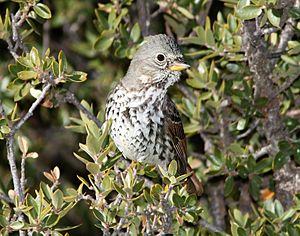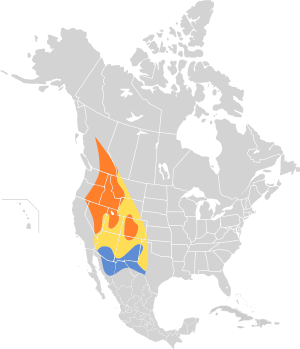Slate-colored fox sparrow facts for kids
Quick facts for kids Passerella iliaca schistacea |
|
|---|---|
 |
|
| Scientific classification |
|
| Kingdom: | Animalia |
| Phylum: | Chordata |
| Class: | Aves |
| Order: | Passeriformes |
| Family: | Passerellidae |
| Genus: | Passerella |
| Species: | |
| Subspecies: |
P. i. schistacea
|
| Trinomial name | |
| Passerella iliaca schistacea Baird, 1858
|
|
 |
|
The slate-colored fox sparrow (Passerella (iliaca) schistacea) is a type of bird found in the Rocky Mountains. It belongs to the same family as other fox sparrows. Scientists are still studying its genes to understand how it is related to other sparrows.
For a long time, people thought this bird was a separate kind of sparrow because it looked different. Later, scientists used DNA information to confirm it was unique. They found it was different from the thick-billed fox sparrow, even though they look similar. The slate-colored fox sparrow seems to be most closely related to the red fox sparrow.
This bird likes to live in areas with short willow bushes in mountain regions. You can find it from British Columbia in Canada all the way south to Nevada and eastern California in the United States. It has a small beak, a gray head and back, brown wings, and brown streaks on its chest. Its tail is a reddish-brown color.
Contents
Types of Slate-Colored Fox Sparrows
Just like other "fox sparrow" groups, the slate-colored fox sparrow has different types, called subspecies. These subspecies look a bit different from each other and live in separate areas. However, they are still very similar genetically because they are all quite new in terms of evolution.
Most of these subspecies are hard to tell apart just by looking at them. Some experts think it might be simpler to group them into just two main types: the northern form (called altivagans) and the southern forms (called schistacea).
Slate-colored fox sparrows like to build their nests near wet areas, similar to red and sooty fox sparrows. But they are not as picky about which plants they use for their nests. Their call sounds like a sharp klink or a sharp smack.
Here are some of the known subspecies:
Schistacea Subspecies
- schistacea Baird, 1858
- This type breeds in specific spots in the mountains. It likes short willow habitats near water.
- You can find it from Crowsnest Pass in British Columbia and Waterton Lakes Park in Alberta, south through the Great Basin mountains. It goes as far as northern Nevada, Wyoming, Colorado, and a bit into northern New Mexico.
- In winter, it moves closer to the coast, mostly in southern California.
- Its head and back are slate gray, with some brown on the back. Its wings, rump, tail, and spots on its underside are a rich dark brown. The tail is a bit more rusty.
Altivagans Subspecies
- altivagans Riley, 1911
- This type breeds inland from central British Columbia to the Crowsnest Pass area.
- In winter, it mainly lives in the Cascade Range and Sierra Nevada in California. It also goes to coastal areas southwest of this, reaching northern Mexico.
- It looks similar to schistacea, but its back is more brown. Its wings and tail have a noticeable rusty color. It looks a bit like a mix between schistacea and the eastern fox sparrow, but its calls and DNA are very different.
Other Subspecies
- canescens Swarth, 1918
- This type breeds in mountain ranges in central Nevada and California, like the Shoshone Mountains and White Mountains.
- It spends winters near the California-Arizona-Mexico border.
- It is very similar to schistacea but looks a bit grayer overall.
- olivacea Aldrich, 1943
- This type breeds from the Nelson area in British Columbia, south along the eastern slopes of the Cascade Range. It might also be found in northern Idaho and northwestern Montana, reaching the Blue Mountains of Oregon.
- In winter, it travels to California and northern Mexico.
- It is also very similar to schistacea. It is darker and browner than schistacea, with an olive tint instead of red. Its beak is small, like schistacea.
- swarthi Behle & Selander, 1951
- This type breeds in Bannock County and Bear Lake County, Idaho, and through mountain ranges in Utah.
- Its winter home is not fully known.
- It is a very gray bird with a strong pattern on its chest.
References
- Rising, Jim D. & Beadle, David (1996): A Guide to the Identification and Natural History of the Sparrows of the United States and Canada. Academic Press, San Diego. ISBN: 0-12-588971-2
- Sibley, David Allen (2000): The Sibley Guide to Birds. Alfred A. Knopf, New York. ISBN: 0-679-45122-6
- Swarth H. W. (1920): Revision of the avian genus Passerella with special reference to the distribution and migration of the races in California. University of California Publications in Zoology 21: 75–224.
- Weckstein, J. D.; Kroodsma, D. E. & Faucett, R. C. (2002): Fox Sparrow (Passerella iliaca). In: Poole, A. & Gill, F. (eds.): The Birds of North America 715. Academy of Natural Sciences, Philadelphia, PA & American Ornithologists' Union, Washington, D.C. Online version, retrieved 2006-11-27. (requires subscription)
- Zink, R. M. (1994): The Geography of Mitochondrial DNA Variation, Population Structure, hybridization, and Species Limits in the Fox Sparrow (Passerella iliaca). Evolution 48(1): 96–111. (HTML abstract, first page image)
- Zink, Robert M. & Kessen, A. E. (1999): Species Limits in the Fox Sparrow. Birding 31: 508–517.
- Zink, Robert M. & Weckstein, Jason D. (2003): Recent evolutionary history of the Fox Sparrows (Genus: Passerella). Auk 120(2): 522–527. [Article in English with Spanish abstract] DOI: 10.1642/0004-8038(2003)120[0522:REHOTF]2.0.CO;2 HTML fulltext (without images)

